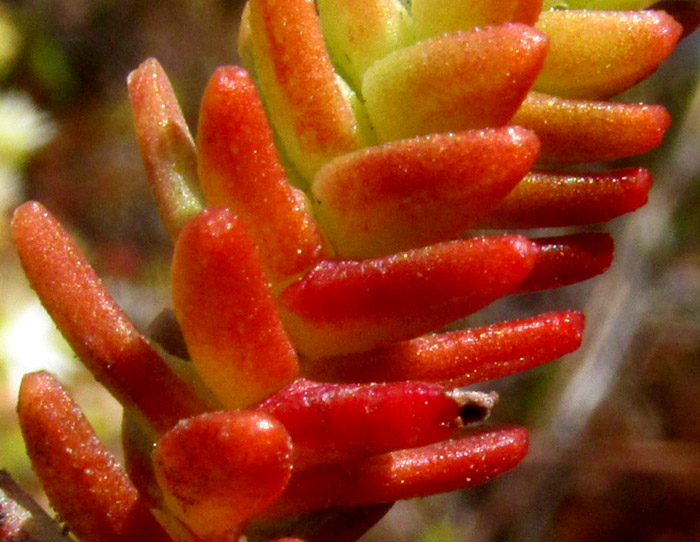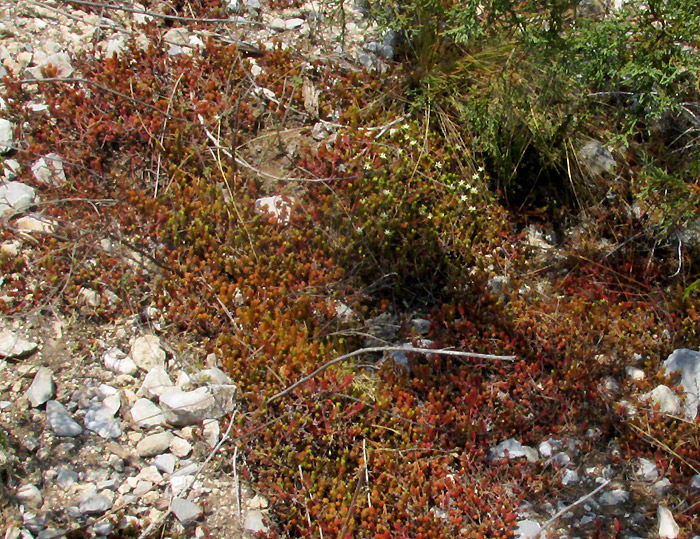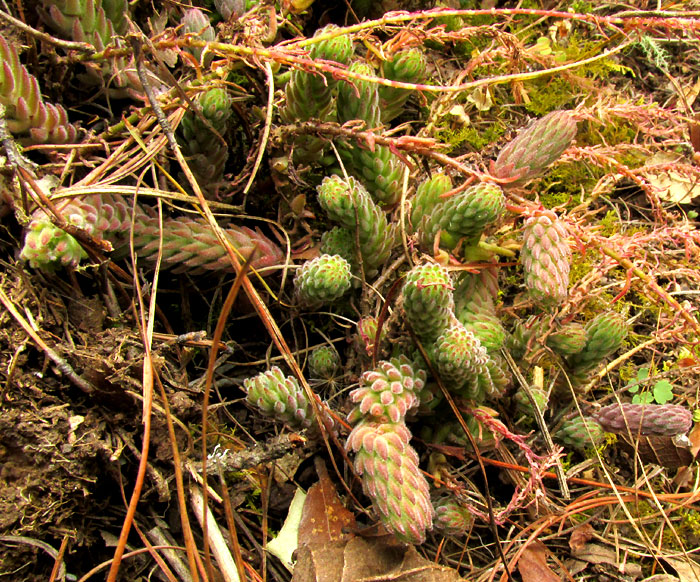Excerpts from Jim Conrad's
Naturalist Newsletter
entry from field notes dated May 4, 2023, taken about 150m upslope on NE-facing slope, above intersection of road from Hwy 120 to San Joaquín, with road to El Doctor; juniper and pine forest on limestone bedrock; elevation ±2425m (7950 ft); Eastern Sierra Madre mountains of east-central Querétaro state, MÉXICO, (N20.88°, W99.62°)
RED STONECROP FLOWERS & LEAVES

Earlier this year we saw flowering Red Stonecrops, Sedum moranense, at a later stage of development, with dried, reddish blossoms {next entry below}. Above, we see a flower at its peak; it's open later in the season than the earlier one, but at an earlier stage of development. Note the flower's classic five green sepals alternating with five white petals, but instead of the five stamens and a single pistil we might expect, there are ten stamens and five pistils.
That's all exactly right for the Stonecrop Family, the Crassulaceae, and the Stonecrop Genus, Sedum. The number of pistils may vary a little, but the number of stamens normally is twice the number of pistils. Each pistil matures into a follicle-type fruit, which is a dry fruit developed from the ovary's single compartment, or carpel, and contains two or more seeds. These features are shared with many other stonecrop species, so often vegetative features most clearly distinguish the species.

However, stonecrop vegetative features vary dramatically, depending on which part of the life cycle it's displaying, and environmental conditions. If you compare the young, closely packed leaves shown above with those on the plant profiled in the next section, they're very different. On the plant profiled below, not only are the flowers past their prime, but also the stems are much longer and the leaves grow farther apart. The leaves themselves flatten as they mature. Moreover, below, notice that only the plants shaded by the juniper are flowering, while more exposed plants aren't, plus where there's more wind and intense sunlight the leaves are redder:

It's clear that Red Stonecrop vigorously adjusts its color, luxuriance and flowering according to very local environmental conditions. The above colony is established on limestone talus below an old quarry.
entry from field notes dated January 19, 2023, taken along steep, one-lane gravel road ascending forested, northeast-facing mountain slope, elevation ±2,380m (7600 ft); bedrock of Cretaceous limestone; on the south side of Pinal de Amoles, Querétaro state, MÉXICO, (N21.134°, W99.629°)
RED STONECROP, MORE MATURE

On the mossy, shaded, almost vertical face of a roadcut on a steep, usually shaded slope forested mostly with pines, the above succulent dangled from the cut. The dangling stems arose from clusters of finger-like sprouts consisting of many overlapping, crammed together immature leaves that were round in cross section, with reddish, pointed tips:

In the above picture, notice the spindly stems of previous seasons, their leaves mostly dried up or missing.

Several dangling, leafy stems bore cyme-type inflorescences at their tips, cymes being flower clusters with a central stem bearing a single terminal flower that develops first, with later flowers developing on side branches as terminal buds. On the above flowers the reddish petals are somewhat withered probably because of an ongoing drought. Notice that each flower bears five pistils united at their bases, each pistil comprising an ovary, style and stigma, with the ovaries connected at their bases, like garlic cloves. Each pistil will develop into a follicle-type fruit, follicles being dry fruits derived from an ovary's single chamber, or carpel, and opening along one side only, to release seeds.
Also in the above picture, notice that the leaves are broad-based, with the bases partly surrounding the stem, and that the leaves are short-hairy.
Succulent plants with such stems, leaves and inflorescences are recognizable to gardeners and those familiar with wildflowers as stonecrops, or maybe sedums, genus Sedum. Stonecrops belong to the Stonecrop Family, the Crassulaceae. Cultivated stonecrops often occur in rock gardens and as potted plants, while in the wild they're typical of dry, rocky environments. Sedum is a big genus, embracing maybe 400-500 species. Mostly they occur in the Northern Hemisphere, but they're also found in Africa and South America. Mexico is home to around 110 species, and just in the Bajío region of upland central Mexico some 26 species have been documented.
In our area, if you have a non-woody Sedum whose stems lie on the ground or dangle, the leaves are round in cross section, and the flowers are reddish, you have SEDUM MORANENSE.
Sedum moranense is endemic just to the highland central Mexican states of San Luis Potosí, Guanajuato, Hidalgo, and here in Querétaro. It occurs in oak, oak-pine and pine-juniper forests, as well as various dry, grassy environments. In English it's often referred to as the Red Stonecrop, its English name owing to its fame as a much commercialized, easy to grow-and-reproduce garden and pot plant. Judging from ads on the Internet, it's especially admired in England.
One fascinating and growing use of Red Stonecrop is as an excellent species for many green or living rooftops and walls -- both by gardeners, and for the ecological greening of urban spaces. Green roofs are shown to reduce energy consumption in buildings, and to diminish the urban heat island effect.
Sedum moranense is yet another species introduced to science when it was collected by Humboldt and Bonpland during their exploration of Mexico in 1803 and 1804. They shipped their collections to the German botanist Carl Sigismund Kunth, who published the name Sedum moranense in the 1823 issue of Nova genera et species plantarum.